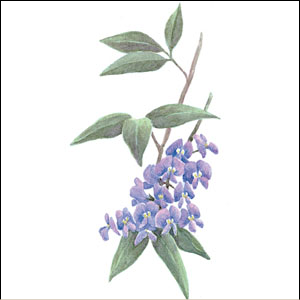Welcome to the days of Hardenbergia comptoniana
Here we are at the end of January and outside our south facing windows waits my gorgeous Hardenbergia - Hardenbergia comptoniana, an Australian native was named for Franziska, Countess von Hardenberg, sister of Baron Carl AA von Hugel, a 19th century Australian patron of botany. H. comptoniana belongs to the Papilionaceae family. According to Botanary, this family name is from the Latin papilio (butterfly), after the shape of the pea and bean flowers.
When most of the rest of the yard is still sleeping this amazing plant starts a 4-5 week show of sweet pea shaped flowers on vines that will grow to the size you want them to be. If it gets too rambunctious just whack it back. Mine gets full sun in the spring and then doesn't mind a bit of afternoon shade later in the summer. We also planted them on the fence at the PG&E substation on Market Street here in Colusa. They are thriving and will move along the fence to mask the industrial yard behind it.
It is also known as coral pea, native lilac vine, wild sarsaparilla and wild wisteria and has a twining vine that can take off if you aren't paying attention but responds to the pruning shears quite well. It received regular water while young and now has very low moisture requirement after about six years. Once it is established, it can take quite a bit of dry weather if grown in light shade. Feed a well balanced fertilizer every two to three months.
Pruning can be done after blooms fade. For a thicker vine, prune the vine only where it twines around itself. It is important to note that this vine will scramble across the ground and wrap itself around other plants. Keep a watchful eye out for this tendency.
There are cultivars which have more shrub-like growth habits such as the H. violacea ‘Mini Haha'. Blooms appear from winter through spring in a variety of colors including white, pink and various shades of purple.
Plant one in an area that needs some early color and just enjoy the evergreen beauty of this “hardy” bergia!!
